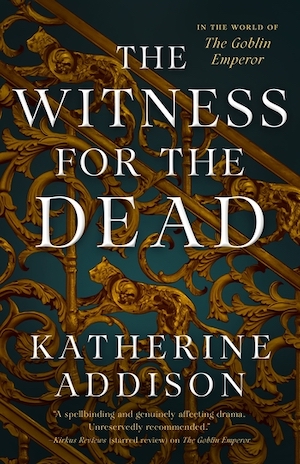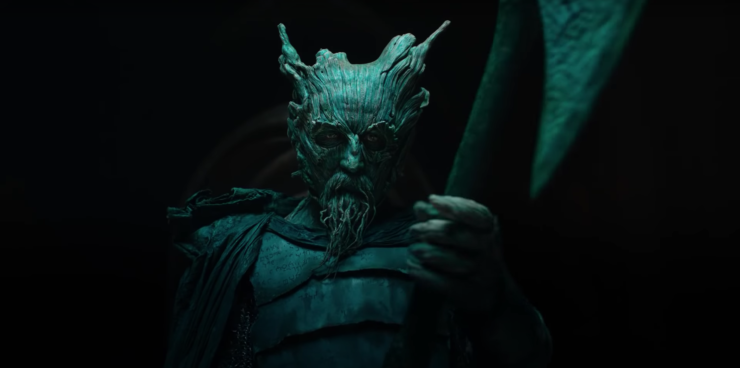On May 11, A24 dropped the long-awaited trailer for The Green Knight, directed by David Lowery and starring Dev Patel. The film, ironically delayed for a year thanks to COVID-19, adapts a delightfully bizarre medieval tale from the late 14th century, in which the titular Green Knight crashes Camelot’s Christmas party and demands someone behead him, and be willing to be beheaded one year later (or one year and a day, according to the J. R. R. Tolkien translation). Sir Gawain accepts the challenge in order to preserve the honor of the court and keep the king from accepting the challenge himself. As you might expect with a giant, mythical green man who likes to play beheading games, the Green Knight picks up his severed head and leaves after reminding Gawain of his promise.
A year later, Sir Gawain ends up at a castle near the Green Knight’s favorite haunt and enters into another Christmas game: the exchange of winnings. The lord of the castle will give Sir Gawain anything he captures while hunting, and Sir Gawain will give the lord anything he captures while resting at the castle. The lady of the castle wastes no time in kissing Sir Gawain, and Sir Gawain dutifully passes these kisses onto the lord… but on the third day of the exchange, fails to turn over a green and gold girdle that the lady swears will keep him from harm. The Green Knight—who was really the lord of the castle—then lowers the axe twice on Gawain’s neck without hitting him, to reward his honesty, and nicks him on the third, to punish him for holding back the girdle.
Buy the Book


The Witness for the Dead
As is often the case in Arthurian legends, Morgan le Fay’s behind it all (she was trying to punish Queen Guinevere) and a humbled, repentant Sir Gawain returns to Camelot, vowing to wear the girdle to remind him of his failure. A later contribution to the original manuscript suggests that the other knights invent the order of the garter in his honor.
For medievalists and Arthurian aficionados, this is an extremely exciting new adaptation, reaching back to early source material that’s often translated, but seldom adapted for the big screen. One half of this article’s authors (Elyse) is personally thrilled to see her favorite knight, Sir Gawain, back in the spotlight once more. Though only Sir Lancelot featured in more medieval tales of the Round Table, Sir Gawain is often given short shrift in modern adaptations because he isn’t part of the central adultery and incest plots that cause the fall of Camelot, and his most famous adventures can read as strange side quests in the Matter of Britain. The other half (Sean) is more excited to see how an arthouse film with an already unique visual style will handle the strange mix of eldritch paganism and early Catholicism that is medieval English Christianity, and how it will flesh out the Round Table. (He hopes that his favorite, the Grail Knight Sir Percival, will make an appearance). And, like most of Twitter, we’re extremely excited to see Dev Patel take on such a rich leading role full of magic and adventure.
But of course, we have some questions.
What’s up with the fox?
In the trailer, a fox kindly informs Sir Gawain, “Your doom is at hand!” Though there is a long history of medieval talking animals (way before Redwall, we had Reynard the Fox, a literary cycle about a trickster figure in a world of anthropomorphic animals), the original poem is bereft of talking animals.
On the third day of the exchange of winnings, the lord of the castle hunts and kills a non-talking fox, which he offers to Sir Gawain, in exchange for whatever Sir Gawain won that day at the castle. The poem does allude to Reynard when describing the fox, however, to signal there’s trickery at hand: Sir Gawain gives the lord of the castle the three kisses he received from the lady of the castle, but not the green and gold girdle the lady also gave him. In the trailer, the fox gives Sir Gawain a warning, and in the poem, the dead fox is an omen: Sir Gawain is attempting to be tricky, but the Green Knight will catch him anyway.
Is this the same fox? Are they trying to make us feel bad about the exchange of winnings? Is this a different fox who just wants to be Sir Gawain’s buddy?
Where did those giants come from?
In between Sir Gawain lopping off the head of the Green Knight, and setting off to find the Green Knight again, Tolkien’s translation informs us that “So many a marvel in the mountains he met in those lands/ that ’twould be tedious the tenth part to tell you thereof.” The text breezily skims over wood-trolls and “ogres that hounded him from the heights of the fells.”
Are these giants said wood-trolls and ogres? Some other marvel brushed over in the original tale? A new subplot to make Sir Gawain’s quest more difficult? Tolkien’s translation declares the Green Knight “the mightiest on middle-earth in measure of height,” and “the largest man alive,” so are these giants ambling slowly through the mist misdirects—a group of giants Sir Gawain hopes will contain the Green Knight?
Who’s the kid offering to take over Sir Gawain’s quest?
Arthurian legends always tell us how great a knight is, but always show us as they fail in a quest, or struggle to win a battle. It’s well in keeping with that tradition to have Sir Gawain’s quest interrupted by a band of men who steal the axe given to him by the Green Knight, and who tell him to “rest his bones,” instead of continuing on—however, according to the Tolkien translation, Sir Gawain “had no friend but his horse in the forests and hills,” and Sir Gawain’s run-ins with other people were just to ask them, “Hey have you seen a giant Green Knight around here?”
Who is this kid? Why is he interested in the quest? How does someone trying to take Gawain’s quest from him change a story that’s primarily about personal responsibility? Gawain’s failures in text come from the instinct to keep himself safe rather than keeping his word. Is this kid offering Gawain another chance to give up? Is it another aspect of the Green Knight? Another obstacle from Morgan le Fay?
Is this technically a Christmas movie?
The poem begins and ends during the twelve days of Christmas, a time when your average resident of medieval England would be telling tales, feasting, and playing games, and all the conflict in the poem revolves around these social exchanges, and the tension between French chivalric custom, pagan practices, and medieval Christian faith.
The trailer shows a beautiful circular calendar that seems to be illustrations of the four seasons pasted onto Fortune’s Wheel—a popular medieval conceit—but how much attention will it pay to the medieval celebration of Christmas? And will The Green Knight soon challenge Eyes Wide Shut for the title of “weirdest movie that takes place around Christmas for some reason”?
How weird is A24 willing to go this time?
It has to be said: Medieval religion was weird. It’s not inaccurate to call the European medieval ages as paganism and Christianity fighting in a sack. In the original poem, the poet spends a long time describing the symbolic meaning of the pentacle on Sir Gawain’s shield. Magical garments and prayers to the Virgin Mary are equally valid options when facing down mystic problems like giant green knights who aren’t affected by beheadings. The poem is known for being disorienting, but that’s a large part of its charm.
A24, to be fair, is no stranger to weird. This is the production company that gave us a scene in The Lighthouse where Robert Pattinson’s character walked William Defoe’s like a dog on a leash before trying to bury him alive, and another in The VVitch, where a hallucinating Puritan mother breastfeeds a raven.
The filmmakers seem to be bringing a version of the medieval symbolic universe on screen, in the slow sequences of Gawain catching on fire while holding an orb and scepter, or traversing desolate landscapes as the camera tilts around him and transforms green wax seals into the moon and into growing circles for plants. The design of the Green Knight also evokes both an eldritch paganism and the paintings of John Howe, who illustrated J.R.R. Tolkien’s translation of Sir Gawain and the Green Knight. How much will the filmmakers lean into the medieval idea of the world, where everything stands in for something else, and that “something else” is ultimately religion? How much of it will be a Jungian exploration of the collective unconscious and the universality of mythic tropes? How much of it will be a conventional epic fantasy?
What questions do you have about The Green Knight, and which moments are you most excited to see on screen?
Elyse Martin is a Chinese-American Smith College graduate who lives in Washington DC with her husband and two cats. She writes reviews for Publishers Weekly, and her work has appeared in Slate, The Toast, Electric Literature, Perspectives on History, The Bias, Entropy Magazine, Publishers Weekly and Smithsonian Magazine. She spends most of her time writing and making atrocious puns—sometimes simultaneously—and tweets @champs_elyse. She’s at work on several novels, and a medieval middle grade graphic novel with Sean Rubin.
Sean studied Art and Archeology at Princeton University, where he met his wife, Lucy. They have two boys and live in Charlottesville, Virginia, where they spend a lot of time building LEGO robots and rambling in the woods. Sean Rubin is a writer and illustrator of comics and children’s books. He is best known for his Eisner-nominated graphic novel, Bolivar, and for his first self-authored picture book, This Very Tree. Sean tweets and instragrams @seancrubin. He’s at work on several picture books, and a medieval middle grade graphic novel with Elyse Martin.











I don’t really know what I want from this, except for weird and wyrd. and it looks like it’s going to deliver.
I’m guessing Gawain’s fox buddy from the Roman van Walewein (another trippy Gawain text) has followed him over into a different adventure.
Don’t forget the devil worshipping imagery of Hereditary.
I have complete confidence in A24 letting their directors go off in whatever directions they please, so I’m sure if David Lowery wanted to go for broke with medieval weirdness they would let him.
Will it be as good as the Virgil Burnett/Theadore Silverstein book? Burnett’s translation coupled with Silverstein’s illustrations were so very, very…Middle English Poem meets 1970’s sensibilities. In the best of ways.
C S Lewis wrote about “Etins” (giants) came blowing after (Gawain) on the high fells, so I think that’s where that scene comes from. I certainly thought about it on seeing the trailer.
Wee question – why was the film ‘ironically’ delayed for a year?
I’m sold.
It’s been too long since I’ve read it, so I had no recollection of there being giants mentioned (in passing) in the text. I just figured that they were trying to add a little action to a story that is, to be fair, very light on action. So now they are just earning extra credit!
Could this be the gateway drug to a whole generation of Arthurian features? We can but hope, gentles all!
ALSO: Will we be getting THE ADVENTURE OF THE LADY & SIR LOVELY-HANDS I’ve been yearning to read since first reading the tale of Sir Gareth and the Lady Lynette?